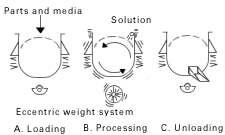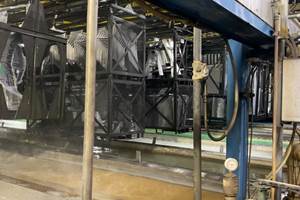Understanding Vibratory Finishing Revisited
A summary of a popular four-part series that appeared in Products Finishing...
Vibratory finishing has not changed much during the years. Several years ago, Products Finishing published a series of articles by John Kittredge. These articles have good, pertinent information that is still valid for the vibratory finishing industry today. The series covered media, compound solution, equipment and parts.
Four elements are significant in vibratory finishing: parts, media, compound solutions and equipment. These link to form an interdependent network, or Tetrahedron of Interdependence. These elements depend on each other to such an extent that if one fails, the process fails.
Media
Media is one of the supporting parts; however, it is also supported by the other three parts.
Functions. The chips or stones in vibratory finishing are called media. While there are many variations, from aggressive grades capable of removing large quantities of metal from parts in short cycles to media that cannot cut at all. Each type has the following functions:
1. Separate and cushion parts. Parts are mixed with media in a random distribution. The ratio of parts to media helps control the amount of contact the parts have among themselves. If insufficient media is between the parts, they will collide. Media cushions this impact so that irreparable damage does not occur. This is not important for forgings, but is a key consideration of preplate finishing of die castings.
2. Contact critical edges and surfaces. Certain media shapes may lead to a false sense of security. Plastic cones are popular and available in a variety of sizes. That pointed end can touch all areas of a part, but if the cone is large and not a blend of sizes, the pointed end does not do much work.
3. Provide proper degree of cut or luster. Abrasive media will cut. More and bigger abrasive will result in more cut. Non-abrasive media can only produce luster.
4. Resist lodging in parts. If media sticks in the parts, someone must remove it. If this is difficult, the cost of removal may exceed the cost of the process. To prevent lodging, manufacturers of media produce a great variety of shapes and sizes.
5. Permit separation from parts. Any time you mix parts and media, the two must eventually be separated. The efficiency of this operation depends on the equipment available, but also on the shape and size of the media and parts.
Abrasive media has distinct functions. It releases abrasive slowly into the system. It can cut and deburr edges. It can develop the required surface smoothness and will last as long as possible.
Media wears and exposes fresh grains. Media also wears against other media, which it is designed to do. This keeps media clean and ready to cut with fresh abrasive.
The rate of media wear varies with use. Media designed for rotary barrels will wear out too fast in higher energy equipment such as vibratory systems. Media designed for vibratory use wears out too fast in barrels and other centrifugal equipment.
Abrasive particle size controls the depth of cut. Bigger particles cut deeper and produce rougher surfaces. The hardness of the abrasive should be greater than the material being cut. This cutting action removes burrs and changes the surface contour.
Surface smoothness can be measured using a capacitive sensing probe. Units are read in microinches or micrometers, AA or arithmetic average. Developing good, smooth, low-micro-inch surfaces is easily done, but care must be exercised. Fast cutting products give rougher surfaces at their minimum capability.
The ideal media lasts forever, and this can happen with non-abrasive media such as steel, but not with abrasive media. Heavy-cutting grades wear faster.
Non-abrasive media peens or pound edges and surfaces. It also deburrs edges lightly while brightening surfaces. It also experiences little or no wear or loss.
Since non-abrasive media cannot cut and energy is imparted to it, it can only pound surfaces and edges. No scratch pattern develops; instead, a series of small, uniform dents is imparted to the surface of the work.
The small dents are followed by more and more pounding until the surface gets brighter. This occurs quickly with steel media on malleable metals, but may never develop on hard steels.
Media wears primarily by rubbing against other pieces of media until abrasive grains fall out or are cut away. With no abrasive, cutting stops and so does wear.
Media has an amazing influence on the vibratory finishing process. However, for the media to work, the solution system must behave, the equipment must perform and the parts must be uniform and above all, people must not make waves too high for the process to get through.
Compound Solution
The compound solution is the least understood and most frequently abused part of the mass finishing process. It has the following functions:
1. Control pH, foam and water hardness. Many compounds are buffered to prevent big changes in pH from taking place. Mass finishing solutions vary from a pH 1 to 14. The most popular range is from 4 to 14.
Some foam is necessary in most applications, especially those involving cleaning. Foam holds the solution in place on the surface of the parts and media. Without foam, process cycles are greatly extended or cleaning just does not occur.
Too much foam kills the action in a vibratory machine. It cushions the mass so effectively that cutting can literally come to a stop. In rotary barrels or centrifugal barrels, however, foam merely moderates action.
In the U.S. water hardness varies from low to high, and public water supplies are often quite different from water drawn from a well in the same area. These great variations in hardness strain the solution since it tried to equalize the differences.
2. Wet surfaces. If the compound solution will not wet or spread on the surface to be cleaned, it will not clean well. Wetting is dependent on concentration.
3. Emulsify oily soils. Physical action improves the speed and stability of emulsification. Because vibratory finishers are excellent scrubbers, they clean well. Media continually works the soils, allowing sometimes-marginal cleaners to "get away with it."
4. Remove tarnish or scale. Both high- and low-pH compound solutions can chemically attack tarnish and scale. These oxides of the metal darken the surfaces and lower reflectivity. Highly alkaline solutions remove rust or scale from some steel. These alkaline solutions can produce light, bleached metal surfaces. Strongly acidic solutions vigorously attack rust and other metal oxides. Unfortunately, they also attack the base metal unless the solution is properly inhibited.
5. Suspend soils. Soil removed or made during the process can redeposit on the parts, media and/or lining of the chamber. Excessively hard water contributes to the problem. Usually a special compound is needed to overcome this.
6. Control lubricity. For years, it was believed that the solution had to be slippery to burnish or brighten a part. This is often true in rotary barrels. In vibratory equipment, excessive slip brings everything to a halt. Traction is lost. Media stops rolling, and nothing happens to the parts. Lubricity should not be completely eliminated, since some lubricity does assist the cutting of the compounds.
7. Control part color. Coloring or darkening parts in vibratory finishing is caused by oxidation or dirt impregnation. Highly alkaline surfaces can bleach out surfaces and acidic compounds can give too clean a surface.
8. Prevent corrosion. The only way to stop corrosion is to include an inhibitor in the compound solution. Some inhibitors are effective on ferrous metals, while others are more effective on non-ferrous metals or those that will oxidize.
9. Provide cooling. If a vibratory process were to run dry, friction would generate high temperatures quickly. The solution cools the mass of media and parts. Low flow rates do not carry away heat as fast. Then more oxidation occurs. Elevated temperatures are seldom needed, even for severe cleaning problems.
Solution Feed
There are three major types of solution-feed systems: batch, recirculation and flow-through. Batch is the simplest system. It is used in barrels and vibrators with no drains. Recirculation systems mix a solution in the tank and pump it into the process, allowing it to drain back into the tank for reuse. This sounds efficient, however the high rate of soil production creates severe contamination problems. Flow-through systems pump fresh solution into the machine, allow it to act and then drain it. Compound flow-through means the parts see only clean media. The solution is always the same strength. There is no sludge tank to clean.
There are three methods of adding compound: manual, batch premix and automatic.
With the manual procedures, you add compound and water manually using a measuring device. In the batch premix method the solution is held in a tank where it is mixed prior to being pumped into the machine. Automatic addition employs a compound-metering pump and rotameter for measuring flow rate of water.
Equipment
Equipment serves several functions.
1. Process parts. The equipment must do the deburring, cleaning, surface conditioning or burnishing.
2. Separation. Separation skills are high on the normal system capability list. The simplest separators are screens. For parts with projections that would cause them to hang up on screens, the tie rod deck is a good choice. It allows parts to slide down parallel rods while the media drops through. Or the inverse if the parts are smaller than the media.
3. Control mass action. Equipment must have adjustments so that more aggressive or gentler work can be done. Tub-type vibratory equipment has a variable-weight system to adjust energy input. Generally, there is a single shaft mounted directly underneath the tub. On each end is an eccentric weight that has some variability in its mass. More weight, more amplitude, faster cutting, rougher surfaces, greater media wear.
The rotational speed of the eccentric weights is another variable. Higher speed generally promotes faster cut, rough surfaces and greater media wear rates.
In round vibratory equipment, the eccentric weights are mounted on each end of a vertical shaft or motor in the center tube of the tub. The amount of weight on the top eccentric generally controls the speed of mass travel around the tub, while the amount on the bottom controls the rollover rate of the mass.
| TABLE I - Media-to-Part Volumetric Rates | |
| Media-to-Part Ratio by Volume |
Normal Commercial Application |
| 0:1 | No media. Part-on-part. Used for beating off burrs. No media for cutting. |
| 1:1 | Equal volumes of media and parts. Forgings, sand castings; to produce crude, very rough surfaces. |
| 2:1 | More gentle, more separation. But still allows relatively severe part-on-part damage. |
| 3:1 | About minimum for non-ferrous parts. Considerable part-on-part contact. Fair-to-good for ferrous metals. |
| 4:1 | Probably average for non-ferrous parts. Good for ferrous metals. |
| 5:1 | Good for non-ferrous metals. Minimal part-to-part contact. |
| 6:1 | Very good for non-ferrous parts. Common for preplate on zinc with plastic media. |
| 8:1 | For higher quality preplate finishes. |
| 10:1 to 20:1 | Even better. Used for very irregularly shaped, fragile parts. |
| Infinite | Absolutely no part-to-part contact. One part per machine or compartment or the part is fixtured. |
Parts
The most important of the Tetrahedron of Interdependence is parts. Without the parts, there would be no process. And, depending on the requirements for the parts, the process is designed, equipment is chosen, media and compound solution are selected. Only when a new process is set up to use existing equipment is the procedure changed. Normally, the parts dictate all else.
There are seven significant purposes of vibratory finishing.
1. Clean. Cleaning can be done with little or no increase in cost, quickly and without heat. Typical parts cleaned commercially in vibratory units include machined engine components, stampings, copper plumbing fittings, brass forgings, plastics, ceramics, rubber and wood.
2. Deburr or radius. This is the best known use of vibratory finishing. All metals, ceramics and some plastics can be deburred. Deburring prevents people from cutting themselves and makes parts feed through automatic feeders more easily.
3. Improve surfaces. Rough surfaces need to be smoothed before they take a high-quality electroplate, paint or anodize. Surface roughness values below 10 microinches AA are common and with good preplate plastic media, values below five microinches are commercially achieved.
4. Brighten. Brightening or burnishing metal surfaces is a good, viable application of mass finishing. It is done easily to the more malleable metals using non-abrasive media. Aluminum, copper, brass and mild steels can be brightened in 10 to 30 min depending on finish quality required and starting surface quality. Harder metals such as stainless, some brasses and other steels take 30 min to several hours.
5. Inhibit. Sensitive metals, including powdered iron, cast iron, copper, brass, zinc and steels of all types will corrode unless protection is provided. Metal surfaces will look cleaner and brighter for longer if they are properly inhibited.
6. Dry. To prevent corrosion or discoloration or to improve parts handling, parts should be dried. Spin basket, hot-air conveyors and dryers filled with ground corncobs can be used.
7. Transfer. Mass finishing is capable of any degree of automation. The easiest transfer to use and one of the most effective is a simple conveyor belt. In-house handling of parts is also important.
Big, heavy parts can crush media, leading to premature media breakdown and higher costs. Crushed or whole media can stick or lodge in parts and be carried out of the vibrator.
One of the worst effects parts can have on media is to soil the media. Oils are especially bad for media if the compound solution cannot remove them rapidly enough. Oil stops cutting and parts emerge dirty or dark.
An important relationship between media and parts is the media-to-parts volumetric ratio. In a mass finishing process, the amount of contact between parts is controlled by the ratio of parts to media. Machine settings control the force of these contacts. This is a statistical phenomenon based on the probabilities involved. If you want smooth parts, keep media levels up. Don't overload the machine with parts.
Parts and people. People make parts. Or at least they control the machines that make the parts. When the quality of the parts is maintained, the vibratory finishing process is consistent. If part quality strays, expect the process to as well.
People make decisions. They make changes that affect the parts. The process cannot. People will muddle the process or keep it simple.
Smart people take every possible advantage of the mechanical process. They insist the process run the same everyday. People rely on the vibratory finishing process and they learn how to use it as an excellent quality control tool.
Related Content
Anodizing for Bonding Applications in Aerospace
Anodizing for pre-prep bonding bridges the gap between metallic and composite worlds, as it provides a superior surface in many applications on aluminum components for bonding to these composites.
Read MoreA Chromium Plating Overview
An overview of decorative and hard chromium electroplating processes.
Read MoreHow to Maximize Nickel Plating Performance
The advantages of boric acid-free nickel plating include allowing manufacturers who utilize nickel plating to keep up the ever-changing regulatory policies and support sustainability efforts.
Read MoreInstalling an Ecoat Line
Thinking of investing in electrocoating capabilities? George Lovell, coatings plant manager for Lippert, discusses considerations you should keep in mind as you add your ecoat line.
Read MoreRead Next
Episode 45: An Interview with Chandler Mancuso, MacDermid Envio Solutions
Chandler Mancuso, technical director with MacDermid Envio discusses updating your wastewater treatment system and implementing materials recycling solutions to increase efficiencies, control costs and reduce environmental impact.
Read MoreDelivering Increased Benefits to Greenhouse Films
Baystar's Borstar technology is helping customers deliver better, more reliable production methods to greenhouse agriculture.
Read MoreA ‘Clean’ Agenda Offers Unique Presentations in Chicago
The 2024 Parts Cleaning Conference, co-located with the International Manufacturing Technology Show, includes presentations by several speakers who are new to the conference and topics that have not been covered in past editions of this event.
Read More























.jpg;maxWidth=300;quality=90)








